
German postcard by Ross Verlag, no. 1488/3, 1927-1928. Photo: Donald Biddle Keyes / Paramount / Parafumet. Gloria Swanson in Stage Struck (Allan Dwan, 1925).

French postcard by Europe, no. 453. Photo: United Artists / Regal Film. Douglas Fairbanks in The Iron Mask (Allan Dwan, 1929).

German postcard by Ross Verlag, no. A 1483/5, 1937-1938. Photo: 20th Century Fox Film. Shirley Temple in Heidi (Allan Dwan, 1937).
Pressed into service as a director
Joseph Aloysius (Allan) Dwan was born in Toronto, Canada, in 1885. Dwan was the younger son of a commercial traveller of woollen clothing, Joseph Michael Dwan and his wife, Mary Jane Dwan (née Hunt). In 1892, Dwan moved with his family to America when he was seven years old and grew up in Chicago. He earned a degree in electrical engineering from the University of Notre Dame, South Bend, Indiana.
He started to work as an electrical engineer in Chicago for Cooper Hewitt Electric Company, installing Cooper-Hewitt lamps at the Chicago Post Office, opposite the Essanay film studio. Essanay exec George K. Spoor thought the lights could prove useful in film photography and contracted Dwan to design a bank of lights.
Dwan had a strong interest in the fledgling motion picture industry, and when Essanay Studios offered him the opportunity to become a scriptwriter, he took the job in 1909. He wrote several screenplays for Essanay, first in Chicago, then in New York and from 1911, part-time in Hollywood.
His first directing assignment arrived almost by accident: he was "pressed into service" by the American Film Co. when one of its directors went AWOL on an alcoholic binge. Dwan operated Flying A Studios in La Mesa, California, from August 1911 to July 1912. Flying A was one of the first motion picture studios in California history.
In 1911–1913, Dwan turned out as many as 250 one-reelers — Westerns, comedies, and even documentaries, which rarely lasted longer than 15 minutes. All were written, edited, and produced by him, but few still exist. In 1913, he signed with the Universal Film Manufacturing Company, but within a year, he moved to the Famous Players Company in New York, and a year after that, he was working with D.W. Griffith at the Triangle Film Corporation.
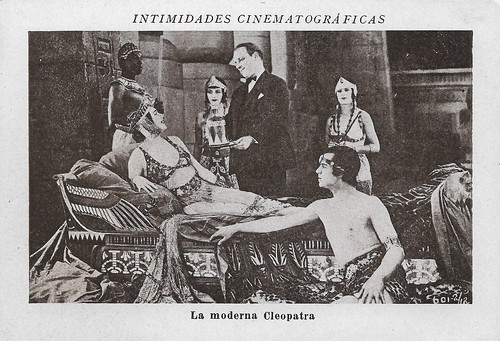
Spanish minicard in the Series Intimidades cinematograficas, series I, card 16 of 20. Nita Naldi in an intermezzo with the director in Lawful Larceny (Allan Dwan, 1923). Caption: The modern Cleopatra.

Italian postcard by Ed. Ballerini & Fratini, Firenze, no. 756. Photo: S.A.I. Films Paramount, Roma. Bebe Daniels, James Rennie and Ricardo Cortez in Argentine Love (Allan Dwan, 1924). Italian release title: Amore Argentino.

Italian postcard by Ed. Ballerini & Fratini, Firenze, no. 759. Photo: S.A.I. Films Paramount, Roma. Bebe Daniels and James Rennie in Argentine Love (Allan Dwan, 1924). Italian release title: Amore Argentino.

American postcard by Photo / Chronicles Ltd., New York, NY, no. S 317. Photo: Paramount / Astoria Motion Picture and Television Foundation. Gloria Swanson in Manhandled (Allan Dwan, 1924).

Italian postcard by Casa Editrice Ballerini & Fratini, no. 743. Photo: S.A.I. Films Paramount, Roma. Gloria Swanson in Stage Struck (Allan Dwan, 1925). Collection: Marlene Pilaete.
The go-to guy
During this time, Allan Dwan was the ‘go-to guy’ as a director, editor, screenwriter and occasional extra. This gave him a sound knowledge of technical aspects as well as dramaturgy and actor direction.
As a pioneer in this field, he was the inventor of the dolly shot in 1915, in which the camera is mounted on a moving automobile and follows the actor's movements. He first used the technique in the film David Harum (1915), in which he filmed a stroll by the actor William H. Crane.
In the same year, he was responsible for solving a technical problem that D.W. Griffith had during the shooting of Intolerance (1916). Dwan invented the equipment used for the crane shots.
After making a series of Westerns and comedies, Dwan was responsible for some of the early successes of Mary Pickford in such films as A Girl of Yesterday (1915) for Famous Players and of Lillian Gish and Dorothy Gish for Triangle. From 1916, he favoured shooting with his good friend Douglas Fairbanks Sr., notably in A Modern Musketeer (1917), the acclaimed Swashbuckling epic Robin Hood (1922) and the part-talkie The Iron Mask (1929).
Dwan also directed Carole Lombard in her film debut, A Perfect Crime (1921), starring Monte Blue. He directed Gloria Swanson in eight feature films at Paramount, including Zaza (1923) with H.B. Warner, Manhandled (1924) and Stage Struck (1925) with Lawrence Gray. In 1925, he also directed Swanson in a short film made in the short-lived sound-on-film process Phonofilm. This short, also featuring Thomas Meighan and Henri de la Falaise, was produced as a joke, with the film showing Swanson crashing the all-male club The Lambs.

Italian postcard by Ed. Ballerini & Fratini, no. 764. Photo: Gloria Swanson in Zazà (Allan Dwan, 1923).

German postcard by Ross Verlag, no. 3658/3, 1928-1929. Photo: United Artists. The card depicts a moment in The Three Musketeers (Fred Niblo, 1921), but stems from when Douglas Fairbanks made the sequel to The Three Musketeers: The Iron Mask (Allan Dwan, 1929).
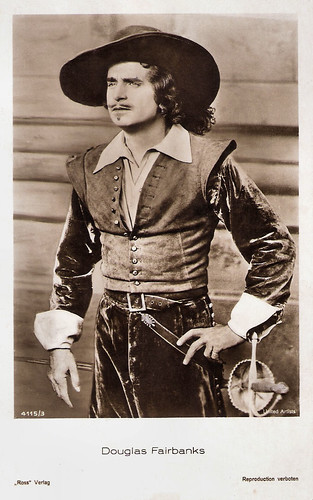
German postcard by Ross Verlag, no. 4115/3, 1929-1930. Photo: United Artists. Douglas Fairbanks in The Iron Mask (Allan Dwan, 1929).

French postcard by Europe, no. 452. Photo: United Artists / Regal Film. Douglas Fairbanks in The Iron Mask (Allan Dwan, 1929).
An exclusive contract with Republic
With the advent of sound film, Allan Dwan's career declined rapidly and after his return from England in 1934 he found himself mainly in B-movies. It was only the commercial and artistic success of two films with Shirley Temple, Heidi (1937) and Rebecca of Sunnybrook Farm (1938), that helped to put him back on the list of directors in demand. In later years, Dwan repeatedly expressed his fascination with the professionalism and acting skills of Temple, who gave some of her best performances under his direction.
He was then allowed to direct the monumental film Suez (1938) with Tyrone Power and Loretta Young for 20th Century Fox, only to sink back to the level of second-rate productions shortly afterwards. It was not until the mid-1940s that his career recovered.
In 1946 Dwan signed an exclusive contract with Republic Studios. Highly acclaimed was his box office hit, the war film Sands of Iwo Jima (1949) starring John Wayne as a hard-boiled Marine. The film follows a group of United States Marines from training to the Battle of Iwo Jima during World War II. The film received four nominations at the 22nd Academy Awards but won no awards.
Moving to RKO Radio Pictures, Dwan made for producer Benedict Bogeaus’s Filmcrest Productions 10 films, among which are some of his most acclaimed. Silver Lode (1954) was a noirish Western that served as an allegory about McCarthyism: the town named in the title turns on beloved citizen Dan Ballard (John Payne) after he is framed for murder by Marshall Ned McCarty (Dan Duryea).
Cattle Queen of Montana (1954) starred Barbara Stanwyck, who, as Sierra Nevada Jones, out-toughs land-grabbers, Indians, and even helpful Ronald Reagan by a wide margin. Slightly Scarlet (1956) was an adaptation of James M. Cain’s novel ‘Love’s Lovely Counterfeit’, about sisters navigating the politics of a corrupt town. The River’s Edge (1957) gave Ray Milland one of his best late roles, as a bank robber trying to make it into Mexico with a suitcase of stolen cash.
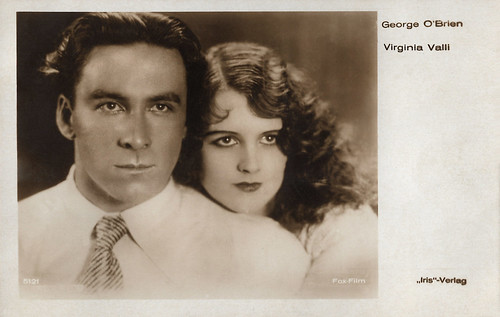
Austrian postcard by Iris-Verlag, no. 5121. Photo: Fox-Film. George O'Brien and June Collier in East Side, West Side (Allan Dwan, 1927).
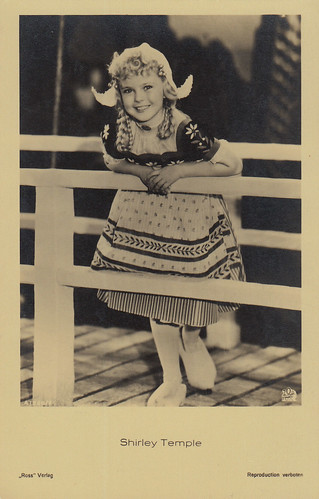
German postcard by Ross Verlag, no. A 1538/6, 1937-1938. Photo: 20th Century Fox. Shirley Temple in Heidi (Allan Dwan, 1937). She's wearing the costume in the fairytale music dance sequence Magic Wooden Shoes: "Once there was a Dutch girl ..."
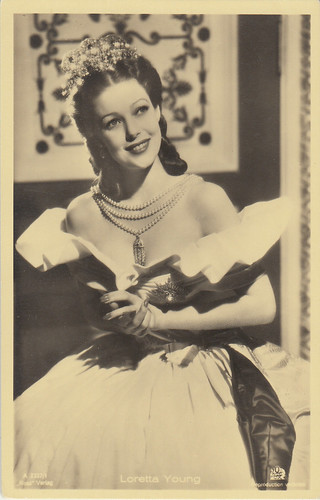
German postcard by Ross Verlag, no. A 2337/1, 1939-1940. Photo: 20th Century Fox. Loretta Young in Suez (Allan Dwan, 1938). Collection: Marlene Pilaete.

British postcard by Real Photograph, London, nr. FS 177. Photo: 20th Century Fox. Tyrone Power and Annabella in Suez (Allan Dwan, 1938), a highly fictionalised biographical account of the builder of the Suez Canal, Ferdinand de Lesseps.
One of the last surviving pioneers of the cinema
Allan Dwan’s last film was Most Dangerous Man Alive (1961) with Ron Randell and Debra Paget. The Science-Fiction thriller was made in 1958 but not released until 1961. Eventually, Dwan directed more than 400 films over 50 years, including 125 features.
In his retirement, Allan Dwan was rediscovered as one of the last surviving pioneers of the cinema. British film historian Kevin Brownlow devoted a chapter to Dwan’s reminiscences in his study of silent-era Hollywood, ‘The Parade’s Gone By’ (1968).
Peter Bogdanovich wrote the biopic ‘Allan Dwan, The Last Pioneer’ about him in 1971. Allan Dwan received a star on the Hollywood Walk of Fame and a Los Angeles Film Critics Association Award for lifetime achievement for his services to American cinema. In 1980, he was interviewed at length for the documentary series Hollywood.
A year later, he died of heart failure at the age of 96 in Woodland Hills, Los Angeles. Alan Dwan was married to the actresses Pauline Bush (1915-1919) and Marie Shelton (1927-1949).
Alan Dwan is buried at San Fernando Mission Cemetery in Mission Hills, CA, Section F, Tier 18, Grave 62. He had once used the mission grounds as a location for his silent feature Tide of Empire (1929). Just as he was fond of opening his films with a poem after the main credits, Dwan wrote the epitaph on his grave marker in verse: "Look Down, Oh Lord, and bless me with thy grace / And make me worthy of thy sacrifice / And after death to look upon thy face / And earn, perhaps, a place in paradise".

Spanish postcard by Ed. Sobe. John Agar and Adele Mara in Sands of Iwo Jima (Allan Dwan, 1949).

British postcard in the Picturegoer Series, London, no. D. 628. Photo: RKO Radio. Scott Brady in Montana Belle (Allan Dwan, 1952).

French postcard by Editions P.I., Paris, offered by Les carbones Korès "Carboplane", no. 695. Photo: B.P.S. / Republic. Forrest Tucker in Flight Nurse (Allan Dwan, 1953).

American postcard by Coral-Lee, Rancho Cordova, CA, no. SC17489. Photo: Tony Koroda / 1981 Sygma. Ronald Reagan and Barbara Stanwyck in Cattle Queen of Montana (Allan Dwan, 1954).
Sources: Michael Barson (Brittanica), Wikipedia (Dutch, German and English) and IMDb.
1 comment:
Thank you for this post. Dwan is very closely associated with Croton's Gloria Swanson. I've linked to all this at my blog https://everythingcroton.blogspot.com/2025/05/directed-by-allan-dwan.html
Post a Comment